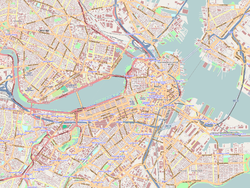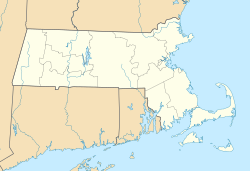Hayden Building (Boston)
In the world of Hayden Building (Boston), we can find a wide variety of elements that allow us to explore and deepen their meaning. From its origins to the present, Hayden Building (Boston) has played a fundamental role in people's lives, significantly impacting multiple aspects. Throughout history, Hayden Building (Boston) has been the subject of study, debate and controversy, which has contributed to the enrichment of knowledge on this topic. In this article, we will delve into the world of Hayden Building (Boston) to understand its importance, evolution and relevance in today's society.
Hayden Building | |
 | |
| Location | 681-683 Washington St., Boston, Massachusetts |
|---|---|
| Coordinates | 42°21′5.18″N 71°3′46.65″W / 42.3514389°N 71.0629583°W |
| Built | 1875 |
| Architect | Henry Hobson Richardson; Norcross Bros. |
| Architectural style | Romanesque |
| MPS | Boston Theatre MRA |
| NRHP reference No. | 80000446 [1] |
| Added to NRHP | December 9, 1980 |
The Hayden Building is a historic building at 681-683 Washington Street in Boston, Massachusetts.
The building was built in 1875 and added to the National Register of Historic Places in 1980 as well as designated a Boston Landmark in 1977 Designed to act as commercial retail space, this four story brownstone building shows little of the ornamentation generally associated with Henry Hobson Richardson. It is the last surviving commercial retail building designed by Richardson in Boston. The building is in Boston's Chinatown neighborhood.
Description
The Hayden Building was the first commercial building built in Richardson's signature "Richardsonian Romanesque," with its quarry-faced ashlar and round-arched fenestration. Countless commercial structures in the late 19th century and early 20th century were later built in this style, but this is the only surviving commercial structure built by Richardson himself.[2] It is constructed of Longmeadow brownstone and is sparsely detailed with granite lintels and arches.
Background
This building was not recorded as a Henry Hobson Richardson building until work done by architectural and landscape historian Cynthia Zaitzevsky made note of it in 1973.[3] Previous summaries of Richardson's works relied on office books. This building was built by the Richardson family and was not charged an architectural or design fee. This building replaced a drugstore that exploded on this site in 1875.[4]
Restoration
Historic Boston Incorporated acquired the building in 1995 and completed a total exterior restoration to repair fire damage.[5] Work was done by the architectural firm Bruner/Cott and Preservation Carpentry students at the North Bennet Street School. Damaged structural stonework was replaced using latex molded cast stone replicas from other parts of the building. Brownstone lintels and columns were replaced where necessary.[6]
In 2011, Boston architectural firm CUBE design + research was commissioned to complete a comprehensive restoration and conversion into multi-family housing.[7]
See also
References
- ^ "National Register Information System". National Register of Historic Places. National Park Service. April 15, 2008.
- ^ Floyd, Margaret Henderson (1997). Henry Hobson Richardson, A Genius For Architecture. The Monacelli Press, Inc. p. 81. ISBN 1-885254-70-9.
{{cite book}}: CS1 maint: date and year (link) - ^ Zaitzevsky, "A New Richardson Building" Journal of the Society of Architectural Historians, Volume XXXII, (May 1977), pg 164-166
- ^ Boston Globe - August 7, 1994 Robert Campbell and Peter Vanderwarker
- ^ "You searched for education".
- ^ "Hayden Building". www.brunercott.com. Archived from the original on November 11, 2006. Retrieved January 13, 2022.
- ^ "HAYDEN BUILDING | CUBE". cubework.com. Archived from the original on October 12, 2012.
External links
- "The Hayden Building"[usurped], Historic Boston.
- "Hayden Building", Atlas Obscura.
- "Hayden building", Massachusetts Historical Commission, 1978, OpenLibrary.org.
- The Hayden Building official site
- City of Boston,Boston Landmarks CommissionHayden Building Study Report



